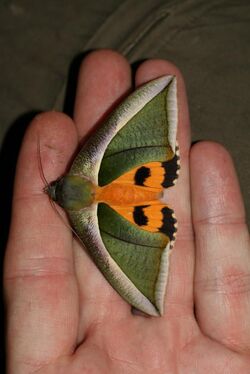Biology:Eudocima salaminia
| Green fruit-piercing moth | |
|---|---|

| |
| Scientific classification | |
| Domain: | Eukaryota |
| Kingdom: | Animalia |
| Phylum: | Arthropoda |
| Class: | Insecta |
| Order: | Lepidoptera |
| Superfamily: | Noctuoidea |
| Family: | Erebidae |
| Genus: | Eudocima |
| Species: | E. salaminia
|
| Binomial name | |
| Eudocima salaminia (Cramer, 1777)
| |
| Synonyms | |
| |
Eudocima salaminia, the green fruit-piercing moth, is a moth of the family Erebidae. The species was first described by Pieter Cramer in 1777. It is found from India , and across south-east Asia to the Pacific Islands. In Australia it occurs in the Northern Territory, Queensland and New South Wales. The adult is a fruit piercer.[1][2]
Description
The wingspan is about 80–104 mm. Palpi with second joint very short and non-spatulate. Forewings with straight outer margin. Cilia non-crenulate. Head and collar plum fruit colored. Thorax greenish with tufts on metathorax. Abdomen orange. Forewings are golden greenish. A broad cream-colored costal fascia runs from near base of inner margin to apex, striated with pale red and turning to green at costa. There is a creamy marginal band as well. A curved red streak found below vein 2. Hindwings orange with large black lunule beyond lower angle of cell. A black marginal band with cilia whitish spots runs from costa to vein 2. Ventral side of forewings fuscous, with orange at base. Broad whitish postmedial band not reaching costa or inner margin. Cilia whitish.[3]
Larva dark purplish grey with a few whitish specks. Somites 4th to 6th with small yellowish sub-dorsal spots, beneath which on 5th and 6th somites is a red-ringed black ocellus with whitish pupil. 11th somite is with a conical reddish dorsal tubercle. Late instar is olive brown with dark specks. A pale lateral fascia found on medial somites and purplish fascia from tubercle to last abdominal segment.
The larvae feed on Stephania japonica and Sarcopetalum harveyanum. Adults are a pest on fruit plantations. They penetrate fruit in order to suck the juices. After the fruit has been pierced, it is vulnerable to fungi and other micro-organisms. Piercing occurs on oranges, lemons and other citrus as well as lychees and longans.[4]
Gallery
References
- ↑ "Fruit piercing moth". Department of Agriculture and Fisheries. https://www.daf.qld.gov.au/plants/fruit-and-vegetables/a-z-list-of-horticultural-insect-pests/fruit-piercing-moth. Retrieved 18 August 2016.
- ↑ "The Fruit-piercing Moths". The New Indian Express. http://www.newindianexpress.com/education/student/The-Fruit-piercing-Moths/2015/01/27/article2638266.ece. Retrieved 18 August 2016.
- ↑ Hampson, G. F. (1894). The Fauna of British India, Including Ceylon and Burma: Moths Volume II. Taylor and Francis. https://www.biodiversitylibrary.org/item/180400#page/5/mode/1up.
- ↑ Herbison-Evans, Don; Crossley, Stella (22 April 2017). "Eudocima salaminia (Cramer, 1777) Green Fruit-piercing Moth". http://lepidoptera.butterflyhouse.com.au/calp/salaminia.html. Retrieved 15 January 2019.
External links
Wikidata ☰ Q5406573 entry
 |






